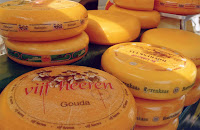These are the Dutch dishes, sweets and bread spreads you should definitely try, while visiting Holland:
Snert: Pea soup, also referred to as snert, is a thick soup made from split peas. Pea soup is found in other countries, but the Dutch version is extremely thick and creamy. The Dutch usually eat this soup during the winter, together with rye bread topped with smoked bacon.
Stamppot: another winter dish with vegetables, potatoes and meat mashed together in one stew. There are varieties with kale, sauerkraut, onions, carrots, sausages and bacon. The final touch is an indentation in the middle of the stew that is filled with gravy.
Cheese: The Netherlands is a real cheese country. More than 674,000 tons of kilos of cheese are produced each year and Dutch cheese is exported to 130 countries around the world. Familiarity with names like Gouda, Edam and Alkmaar (where the famous cheese markets are held) stretches far beyond the national borders. The Dutch eat cheese as a topping on bread, a custom not shared by many non-Dutch.
Poffertjes: A traditional Dutch snack similar to pancakes, but smaller, thicker and sweeter. Poffertjes are usually served with butter and sugar on top. They are extremely popular with children. Most outdoor markets and fairs in the Netherlands have a stand selling this treat.
Patatje met: French fries are not a Dutch invention, but the Dutch have their own unique customs for eating them. Popular toppings are mayonnaise, mayonnaise with peanut sauce, and mayonnaise with ketchup and raw onions, combinations that tend to stupefy visitors from other countries. French fries with a variety of toppings are sold in the Netherlands at snack bars. The people of the northern provinces refer to them as patat, while the southerners call them friet.
 Bitterballen: the best snack when sitting on a terrace with a drink. Small fried balls of beef ragout. The bigger brother of ‘bitterballen’ is a kroket, which is sold at any snack corner.
Bitterballen: the best snack when sitting on a terrace with a drink. Small fried balls of beef ragout. The bigger brother of ‘bitterballen’ is a kroket, which is sold at any snack corner.Vending machines: Snack bars are an integral part of Dutch culture. Hot vending machine snacks include frikadel (minced meat hot dog), croquette and fried croquette balls.
Salted herring (Hollandse Nieuwe): Salted herring is referred to as Hollandse Nieuwe, and is the first young herring of the season that is suitable for consumption. Herring may only carry the Hollands designation if it contains a certain percentage of fat and is prepared in the traditional Dutch manner, i.e. cleaned, filleted and salted. Every year, this herring is introduced in a ceremonial manner at the end of May or in early June. A traditional auctioning of the first barrel of Hollandse herring takes place in Scheveningen, the proceeds of which are donated to charity. The Dutch eat herring as a snack. They grab it by the tail, cover it in raw onions (optional) and hold it in the air in front of their mouth and eat it bite by bite.
Liquorice: Dutch liquorice is available both sweet and salty and in a wide range of shapes and flavors. Nowhere in the world do they eat as much liquorice as in the Netherlands.
Hagelslag: Every day in the Netherlands, no fewer than 750,000 slices of bread are consumed with hagelslag on top, a topping made of chocolate or coloured sugar sprinkles, making it the most popular bread topping in the country. It is a typical Dutch product that is often unavailable in other countries.
Muisjes: aniseed comfits eaten as a bread topping and available with a pink, blue or white outer layer of sugar. It is a Dutch custom to eat rusk with aniseed comfits to celebrate the birth of a baby
Stroopwafel: It can best be described as a waffle cookie that has been cut through the middle and ‘glued’ back together again with caramel. They are best eaten warm, although also often eaten cold. More than 22 million packages of stroopwafels are sold each year in the Netherlands.
Feeling even more adventurous? Check out this NY Times article: Eating Out in Amsterdam: Way Beyond Herring








No comments:
Post a Comment